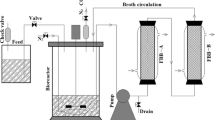Abstract
Clostridium thermocellum/Clostridium thermolacticum co-culture fermentation has been shown to be a promising way of producing ethanol from several carbohydrates. In this research, immobilization techniques using sodium alginate and alkali pretreatment were successfully applied on this co-culture to improve the bio-ethanol fermentation performance during consolidated bio-processing (CBP). The ethanol yield obtained increased by over 60 % (as a percentage of the theoretical maximum) as compared to free cell fermentation. For cellobiose under optimized conditions, the ethanol yields were approaching about 85 % of the theoretical efficiency. To examine the feasibility of this immobilization co-culture on lignocellulosic biomass conversion, untreated and pretreated aspen biomasses were also used for fermentation experiments. The immobilized co-culture shows clear benefits in bio-ethanol production in the CBP process using pretreated aspen. With a 3-h, 9 % NaOH pretreatment, the aspen powder fermentation yields approached 78 % of the maximum theoretical efficiency, which is almost twice the yield of the untreated aspen fermentation.



Similar content being viewed by others
References
Zhu L, O’Dwyer JP, Chang VS, Granda CB, Holtzapple MT (2008) Structural features affecting biomass enzymatic digestibility. Bioresour Technol 99(9):3817–3828
Myung KH, Kennelly JJ (1992) Effect of alkaline hydrogen peroxide and peracetic acid on in sacco ruminal digestibility of aspen sawdust. Asian Australas J Anim Sci 5(4):635–641
Gharpuray MM, Lee YH, Fan LT (1983) Structural modification of lignocellulosics by pretreatments to enhance enzymatic hydrolysis. Biotechnol Bioeng 25(1):157–172
Toyama N, Ogawa K (1975) Sugar production from agricultural woody wastes by saccharification with Trichoderma viride cellulase. In: Biotechnology and Bioengineering Symposium. 5(Cellul. Chem. Energy Resour.):225–244
Huang R, Su R, Qi W, He Z (2010) Understanding the key factors for enzymatic conversion of pretreated lignocellulose by partial least square analysis. Biotechnol Prog 26(2):384–392
Taherzadeh MJ, Karimi K (2008) Pretreatment of lignocellulosic wastes to improve ethanol and biogas production: a review. Int J Mol Sci 9(9):1621–1651
Mosier N, Wyman C, Dale B et al (2005) Features of promising technologies for pretreatment of lignocellulosic biomass. Bioresour Technol 96(6):673–686
Xu L, Tschirner U (2011) Improved ethanol production from various carbohydrates through anaerobic thermophilic co-culture. Bioresour Technol 102(21):10065–10071
Weimer PJ, Koegel RG, Lorenz LF, Frihart CR, Kenealy WR (2005) Wood adhesives prepared from lucerne fiber fermentation residues of Ruminococcus albus and Clostridium thermocellum. Appl Microbiol Biotechnol 66(6):635–640
Lynd LR, Zyl WHV, McBride JE, Laser M (2005) Consolidated bioprocessing of cellulosic biomass: an update. Curr Opin Biotechnol 16(5):577–583
Brethauer S, Wyman CE (2010) Review: continuous hydrolysis and fermentation for cellulosic ethanol production. Bioresour Technol 101(13):4862–4874
Pines G, Freeman A (1982) Immobilization and characterization of Saccharomyces cerevisiae in crosslinked, prepolymerized polyacrylamide-hydrazide. Eur J Appl Microbiol Biotechnol 16(2–3):75–80
Karel SF, Libicki SB, Robertson CR (1985) The immobilization of whole cells: engineering principles. Chem Eng Sci 40(8):1321–1354
Horne PN, Hsu H (1983) Immobilization of Clostridium thermocellum cells on bituminous coal particles. Anal Biochem 129(1):72–79
Jo JH, Lee DS, Park D, Park JM (2008) Biological hydrogen production by immobilized cells of Clostridium tyrobutyricum JM1 isolated from a food waste treatment process. Bioresour Technol 99(4):6666–6672
Park JK, Chang HN (2000) Microencapsulation of microbial cells. Biotechnol Adv 18(4):303–319
Willaert RG, Baron GV (1996) Gel entrapment and micro-encapsulation: methods, applications and engineering principles. Rev Chem Eng 12(1–2):1–205
Gee KB, Choi CY (1984) A study on the ethanol production by immobilized cells of Zymomonas mobilis. Korean J Chem Eng 1(1):13–19
Yamashita Y, Kurosumi A, Sasaki C, Nakamura Y (2008) Ethanol production from paper sludge by immobilized Zymomonas mobilis. Biochem Eng J 42(3):314–319
Nowak J, Roszak H (1997) Co-immobilization of Aspergillus niger and Zymomonas mobilis for ethanol production from starch. Pol J Food Nutr Sci 6(3):65–70
Ryu S, Lee K (1997) Comparison of immobilization matrix for ethanol fermentation by Zymomonas mobilis and Saccharomyces cerevisiae. J Microbiol Biotechnol 7(6):438–440
Doruker P, Onsan ZI, Kirdar B (1995) Ethanol fermentation by growing S. cerevisiae cells immobilized in small ca-alginate beads. Turk J Chem 19(1):37–42
Sluiter A, Harnes B, Ruiz R, Scarlata C, Sluiter J (2009) NREL laboratory analytical procedure: determination of structural carbohydrates and lignin in biomass. 2008
Klein J, Stock J, Vorlop KD (1983) Pore size and properties of spherical calcium alginate biocatalysts. Eur J Appl Microbiol Biotechnol 18(2):86–91
Loomis AK, Childress AM, Daigle D, Bennett JW (1997) Alginate encapsulation of the white rot fungus Phanerochaete chrysosporium. Curr Microbiol 34(2):127–130
He Q, Lokken MP, Chen S, Zhou J (2009) Characterization of the impact of acetate and lactate on ethanolic fermentation by Thermoanaerobacter ethanolicus. Bioresour Technol 100(23):5955–5965
Cheetham PJ, Blunt KW, Bucke C (2004) Physical studies on cell immobilization using calcium alginate gels. Biotechnol Bioeng 21(12):1–14
Collet C, Girbal L, Peringer P, Schwitzguebel JP, Soucaille P (2006) Metabolism of lactose by Clostridium thermolacticum growing in continuous culture. Arch Microbiol 185(5):331–339
Meinecke B, Bertram J, Gottschalk G (1989) Purification and characterization of the pyruvate-ferredoxin oxidoreductase from Clostridium acetobutylicum. Arch Microbiol 152(3):244–250
Bothun GD, Knutson BL, Berberich JA, Strobel HJ, Nokes SE (2004) Metabolic selectivity and growth of Clostridium thermocellum in continuous culture under elevated hydrostatic pressure. Appl Microbiol Biotechnol 65(2):149–157
Simmons R, Costilow R (1962) Enzymes of glucose and pyruvate catabolism in cells, spores, and germinated spores of Clostridium botulinum. J Bacteriol 84(6):1274–1281
Otajevwo FD, Aluyi HSA (2011) Cultural conditions necessary for optimal cellulase yield by cellulolytic bacterial organisms as they relate to residual sugars released in broth medium. Modern Appl Sci 5(3):141–151
Xu L, Tschirner U (2012) Peracetic acid pretreatment of alfalfa stem and aspen biomass. BioResources 7(1):203–216
Kim YK, Kitaoka M, Krishnareddy M, Mori Y, Hayashi K (2002) Kinetic studies of a recombinant cellobiose phosphorylase (CBP) of the Clostridium thermocellum YM4 strain expressed in Escherichia coli. J Biochem 132:197–203
Ren NQ, Li YF, Ding J, Lin HL, Zheng GX, Chui YG (2004) Biohydrogen II: the engineering and applications. Adv Earth Sci 19:542–546
Author information
Authors and Affiliations
Corresponding author
Rights and permissions
About this article
Cite this article
Xu, L., Tschirner, U. Immobilized anaerobic fermentation for bio-fuel production by Clostridium co-culture. Bioprocess Biosyst Eng 37, 1551–1559 (2014). https://doi.org/10.1007/s00449-014-1127-3
Received:
Accepted:
Published:
Issue Date:
DOI: https://doi.org/10.1007/s00449-014-1127-3




